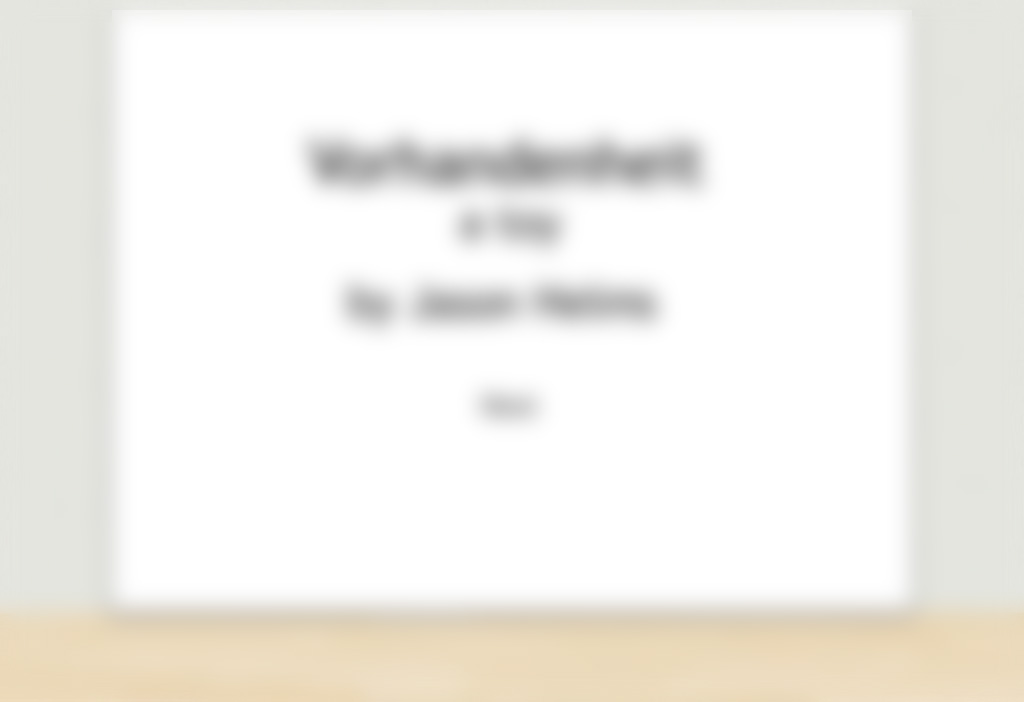


Vorhandenheit
Jason Helms
Abstract
This interactive Flash piece investigates Heidegger's notions of Zuhandenheit and Vorhandenheit in light of recent work in rhetoric, composition, and user design. Heidegger (1962) divided human interaction into two modes: zuhanden (ready-to-hand) and vorhanden (present-at-hand). Zuhandenheit entails a transparent mode of interaction while Vorhandenheit signifies a reflective mode. Recently, this division has been taken up in the fields of user design and human-computer interaction (Bird & Marshall, 2011; Dotov, Nie, & Chemero, 2010). Richard Lanham (2006) described a similar system, which he referred to as looking through vs. looking at. This piece integrates these diverse conversations while distinguishing carefully between the various terms and systems in play. In it, the user is asked to navigate a series of mainly textual arguments via a hidden button game. This initially frustrating navigation becomes a complex, interactive, visual argument co-constructed between user and design.
This webtext was originally created in Adobe Flash, which is no longer available. In the near future, we'll be able to embed an emulator which will allow readers to experience the webtext here on the journal's site, but until that is in place, we have made available a web archive file, which can be opened and read with the WebRecorder Desktop app.
- Dowloadable WARC archive of "Vorhandenheit" by Jason Helms
- WebRecorder Desktop (download and install locally)
See also the transcript linked below.
Transcript
The table in this linked descriptive transcript attempts to describe the interactive flash argument by dividing it into a series of slides.
References
Bird, Jon, & Marshall, Paul. (2011). Empirically investigating the distinction between phenomenally present and phenomenally transparent tools. In Paul Marshall, Alissa N. Antle, Elise van den Hoven, & Yvonne Rogers (Eds.) Proceedings from Workshop on Embodied Interaction: Theory and Practice in HCI (CHI 2011), 84-87. New York, NY: ACM.
Dotov, Dobromir G., Nie, Lin, & Chemero, Anthony. (2010). A demonstration of the transition from ready-to-hand to unready-to-hand. PLoS ONE, 5(3). doi:10.1371/journal.pone.0009433. Retrieved March 11, 2010, from http://www.plosone.org/article/info:doi%2F10.1371%2Fjournal.pone.0009433
Heidegger, Martin. (1962). Being and time. (John Macquarrie & Edward Robinson, Trans.). New York, NY: Harper & Row. (Original work published 1927-1957).
Lanham, Richard A. (2006). The economics of attention: Style and substance in the age of information. Chicago, IL: University of Chicago Press.
Stiegler, Bernard. (1998). Technics and time 1: The fault of epimetheus. (Richard Beardsworth & George Collins, Trans.). Stanford, CA: Meridian.
Stiegler, Bernard. (2002). The discrete image. In Jacques Derrida & Bernard Stiegler (Eds.), Echographies of television (Jennifer Bajorek, Trans.) (pp. 145-163). Malden, MA: Polity Press.